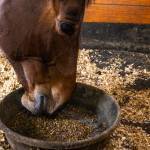What Is the Best Design for Urine Collection in Equine Fractional Excretion Studies?

This study was designed to determine daily variation in urinary clearance and fractional excretion (FE) of electrolytes and minerals within and between horses and to compare volumetric and single-sample urine collection for determining FE values of diets with a range of dietary cation-anion balance (DCAB).
Five Thoroughbred and 6 mixed-breed mares were used. Three isocaloric diets with low, medium, and high DCAB values (85, 190, and 380 mEq/kg of dry matter, respectively) were each fed for 14 days. Daily blood samples, single urine samples collected by using a urinary catheter (5 mares), and volumetric urine collections (6 mares) were obtained during the last 72 hours of each diet. Urine and plasma pH values, plasma concentrations, and FE values of sodium, chloride, potassium, magnesium, phosphorus, and calcium were altered by varying the DCAB.
Noticeable variation in clearance and FE values was detected within horses from day to day on the same diet as well as between horses. Fractional excretion values were not significantly different between single-sample and volumetric methods, except for magnesium in the high DCAB diet. Volumetric and single-sample collections revealed similar patterns of change in urinary FE values with varying DCAB, except for calcium and magnesium.
This study showed that substantial variations in clearance and FE of electrolytes and minerals were evident within horses between 24-hour periods as well as between horses fed a specific diet. Three daily urine samples provided similar information regarding dietary-induced changes in clearance and FE values (excluding calcium and magnesium) as that obtained by volumetric urine collection.
This report of KER’s 2003 research was published in American Journal of Veterinary Research.
Read the entire research paper, titled Comparison of Volumetric Urine Collection Versus Single-Sample Urine Collection in Horses Consuming Diets Varying in Cation-Anion Balance.








